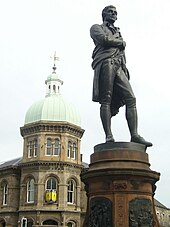



David Watson Stephenson (25 March 1842 – 18 March 1904) was a Scottish sculptor, executing portraits and monuments in marble and bronze.




David Watson Stephenson (25 March 1842 – 18 March 1904) was a Scottish sculptor, executing portraits and monuments in marble and bronze.
Stevenson was born in Ratho, Midlothian, Scotland, on 25 March 1842, the son of William Stevenson and Margaret Kay. [1] He studied at the Trustees' Academy, Edinburgh. From 1860 he took an eight-year apprenticeship under the sculptor William Brodie. [2]
He won the South Kensington National Prize for student sculpture with a statuette of the Venus de Milo and completed his studies in Rome, Italy. [3]
He worked as assistant to Sir John Steell on the Prince Albert Monument forming the centrepiece of Charlotte Square in Edinburgh. [2] Here he added figures of "Science & Learning" and "Labour" on the corners. [4] He became known for his portrait sculptures executed in marble and bronze. His best known and most iconic work is the 1869 bronze figure of William Wallace on the Wallace Monument near Stirling. [2]
He became a member of the Royal Scottish Academy. [5] He lived in a townhouse at 2 Castle Terrace facing onto St Cuthbert's Churchyard at the west end of Princes Street. [6]
Stevenson died on 18 March 1904, aged 61. He is buried with his younger brother, William Grant Stevenson, also a sculptor, in the south-west section of Grange Cemetery in Edinburgh. The bronze portrait relief head of William on the monument was sculpted by Henry Snell Gamley.
Stevenson's most loved and publicly seen statue is the figure of William Wallace on the Wallace Monument in Stirling. [7] This fine statue should not be confused with the far cruder, modern statue near the visitor centre, but stands on the side of the monument itself.
Stevenson made the figures of Mary, Queen of Scots, James VI of Scotland and Halbert Glendinning on the Scott Monument, Edinburgh (1874); the Henry Bolckow Monument, Middlesbrough (1881); Robert Tannahill, Paisley (1884) and (Mary Campbell (Highland Mary)), Dunoon (1896). [2] His sculptures of Sir John Steell a fellow sculptor (1887) and Napier of Murchiston (1898) are held in the Scottish National Portrait Gallery. [4] He also created five of the multiple statues on the exterior of the Portrait Gallery: James Hutton; John Napier; King James VI; James Campbell and Adam Duncan.
He created the Saracen Fountain in cast iron for the Kelvingrove International Exhibition of 1901. It was later moved to Alexandra Park, Glasgow. [2] This included a repeat of three figures from an earlier monument to John Platt (MP) in Oldham (1878). Copies were made for Town Hall Park in Warrington (destroyed 1942) and the Sammy Marks Zoological Gardens in Pretoria, South Africa.
In 1868, he created the impressive Celtic cross as a memorial to Horatio McCulloch on his grave in Warriston Cemetery.
In 1884, he created the statue of Hygieia with Thomas Bonnar's classical "St Bernard's Well" in Stockbridge, Edinburgh.

The Dean Cemetery is a historically important Victorian cemetery north of the Dean Village, west of Edinburgh city centre, in Scotland. It lies between Queensferry Road and the Water of Leith, bounded on its east side by Dean Path and on its west by the Dean Gallery. A 20th-century extension lies detached from the main cemetery to the north of Ravelston Terrace. The main cemetery is accessible through the main gate on its east side, through a "grace and favour" access door from the grounds of Dean Gallery and from Ravelston Terrace. The modern extension is only accessible at the junction of Dean Path and Queensferry Road.

Sir John Robert Steell was a Scottish sculptor. He modelled many of the leading figures of Scottish history and culture, and is best known for a number of sculptures displayed in Edinburgh, including the statue of Sir Walter Scott at the base of the Scott Monument.

The Scott Monument is a Victorian Gothic monument to Scottish author Sir Walter Scott. It is the second-largest monument to a writer in the world after the José Martí monument in Havana. It stands in Princes Street Gardens in Edinburgh, opposite the former Jenners building on Princes Street and near Edinburgh Waverley Railway Station, which is named after Scott's Waverley novels.

James Pittendrigh MacGillivray was a Scottish sculptor. He was also a keen artist, musician and poet. He was born in Inverurie, Aberdeenshire, the son of a sculptor, and studied under William Brodie and John Mossman. His works include public statues of Robert Burns in Irvine, Lord Byron in Aberdeen, the 3rd Marquess of Bute in Cardiff, John Knox in Edinburgh's St Giles Cathedral, and William Ewart Gladstone in Coates Crescent Gardens, Edinburgh.
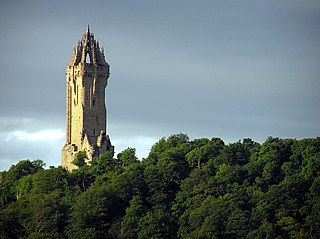
The National Wallace Monument is a 67 metres (220 ft) tower on the shoulder of the Abbey Craig, a hilltop overlooking Stirling in Scotland. It commemorates Sir William Wallace, a 13th- and 14th-century Scottish hero.

Horatio McCulloch, sometimes written MacCulloch or M'Culloch, was a Scottish landscape painter.

Robert Scott Lauder was a Scottish artist who described himself as a "historical painter". He was one of the original members of the Royal Scottish Academy.
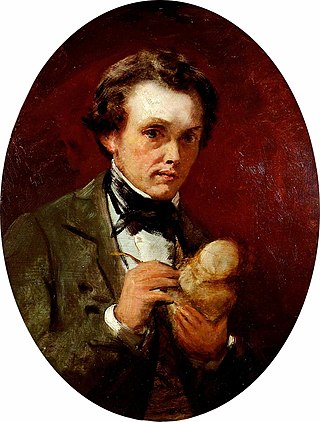
William Brodie was a Scottish sculptor who worked in Edinburgh.
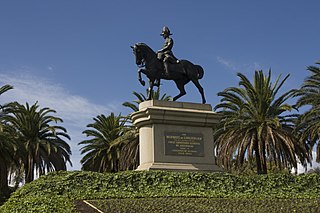
William Birnie Rhind RSA (1853–1933) was a Scottish sculptor.
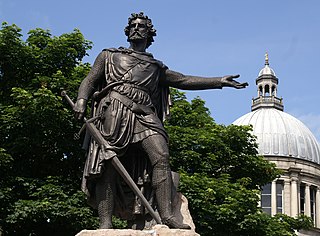
William Grant Stevenson, was a Scottish sculptor and portrait painter.

John RhindARSA (1828–1892) was a Scottish sculptor, based in Edinburgh. He was born in Banff the son of a master mason. He was trained under Alexander Handyside Ritchie (1804–1870). He served this apprenticeship in a yard at 4 East Broughton Place.

Samuel Joseph was a British sculptor, working in the early 19th century.

The statue of Robert Burns in Milwaukee, Wisconsin, is a work of public art by the Scottish artist William Grant Stevenson, RSA. The bronze statue, of the Scottish national poet Robert Burns, stands on a plinth of Nova Scotia pink granite with two bronze bas relief panels. The monument was donated to the City of Milwaukee by James A. Bryden.
Alexander Handyside Ritchie was a Scottish sculptor born in Musselburgh in 1804, the son of James Ritchie, a local brickmaker and ornamental plasterer, and his wife Euphemia. The father in turn was the son of a fisherman and amateur sculptor.
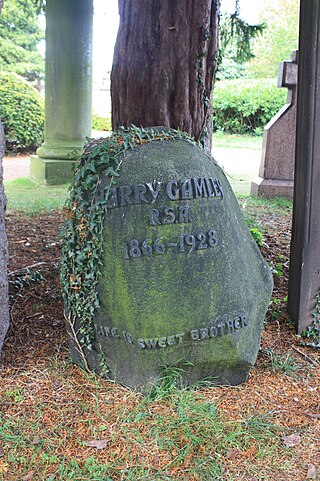
Henry Snell Gamley (1865–1928) was a Scottish sculptor specialising in war memorials and sculpture on tombs. He was however also responsible for other figurative sculpture on prominent Edinburgh buildings such as the Usher Hall and works at Holyrood Palace.

Scottish art in the nineteenth century is the body of visual art made in Scotland, by Scots, or about Scottish subjects. This period saw the increasing professionalisation and organisation of art in Scotland. Major institutions founded in this period included the Institution for the Encouragement of the Fine Arts in Scotland, the Royal Scottish Academy of Art, the National Gallery of Scotland, the Scottish National Portrait Gallery and the Glasgow Institute. Art education in Edinburgh focused on the Trustees Drawing Academy of Edinburgh. Glasgow School of Art was founded in 1845 and Grays School of Art in Aberdeen in 1885.

Patric Park was a Scottish sculptor.

Thomas Stuart Burnett ARSA was a Scottish sculptor in the 19th century.